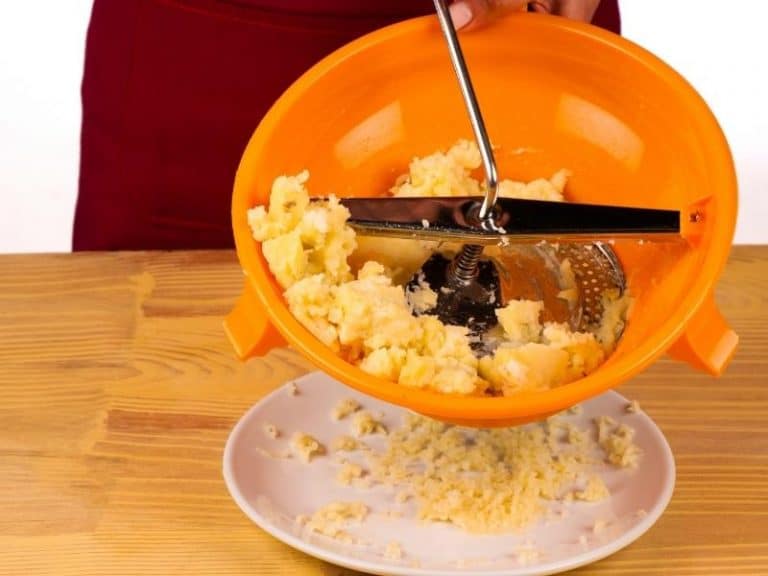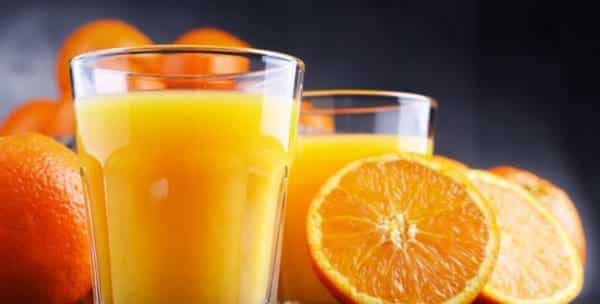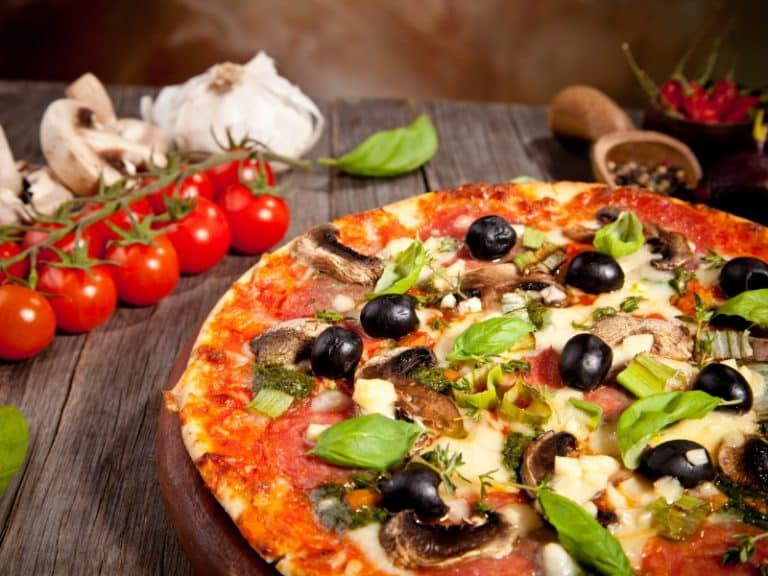What is Farina? Health Benefits And A Recipe You Have To Try
Farina is made from the white pulp inside of wheat grain — called the endosperm — and the germ of the wheat grain. Farina is a milled grain that is only found inside hard wheat, not durum wheat. Because it is wheat-based, farina contains gluten.
In Latin, farina means “flour” or “meal.” To give farina its fine, flour-like consistency, the wheat germ and the endosperm of the wheat grain are milled and sifted.
The most famous wheat farina product is Cream of Wheat. The main ingredient in Cream of Wheat is farina, and flavorings and salts are usually added to this product.
Is Farina Healthy (& Good For Your Diet)?
Farina is healthy because it’s a good source of essential nutrients, including iron, niacin, folate, calcium, and copper. However, farina isn’t suitable for a gluten-free diet because it contains gluten.
People with gluten intolerances should avoid farina. People with gluten sensitivity and celiac disease also shouldn’t eat farina if farina triggers uncomfortable symptoms, like bloating and nausea.
Good farina alternatives for a gluten-free diet are:
- Cream of Rice cereal — a creamy cereal with a slightly blander flavor than farina
- Gluten-free oatmeal — a breakfast alternative that can be made from scratch or bought in ready-made packages
- Almond flour — a flour alternative with a similar consistency to farina
- Buckwheat flour — another flour alternative, which, despite its name, is not a wheat grain and is gluten-free
Certain brands of farina are high in sodium. Instant Cream of Wheat contains over 25% of the recommended daily limit for sodium in a single cooked cup. If you need to follow a low-sodium diet, you should look for the least processed farina products available.
Good farina alternatives for a low-sodium diet are:
- Low-sodium farina products — original farina products are fine. Compare the labels on several farina products and buy the product with the lowest sodium per serving
- Homemade oatmeal (unprocessed) — another breakfast alternative that can be very low in sodium if you choose to make your own from scratch
Farina Health Benefits
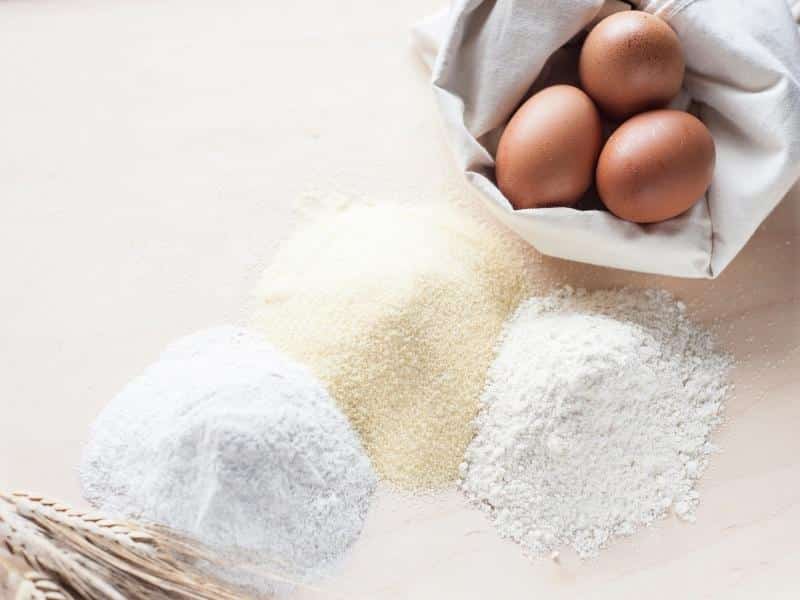
Some of the health benefits of farina are:
Good Vegetarian Source of Iron
Cream of Wheat, a brand of farina that is commonly used as a breakfast cereal or porridge, is a great vegetarian source of iron. Iron is essential for DNA synthesis, oxygen transportation, and the production of red blood cells.
Vegetarians and vegans are at risk of iron deficiency because the majority of iron is found in animal products. A single cup of Cream of Wheat contains over half the recommended daily requirements for iron, making Cream of Wheat an ideal iron-rich breakfast food for people who don’t eat meat.
Getting enough iron from farina and other food sources will keep you energized and alert. Iron can contribute to healthy hair, skin, and nails.
Contains B Vitamins
Farina is a good source of B vitamins. Depending on the brand of farina, this hot cereal can contain up to 35% of your daily recommended intake of niacin. Farina also includes the B vitamins thiamine, riboflavin, and folic acid.
B vitamins are essential for the proper functioning of the body’s cells. The B vitamins in farina can help create new blood cells and allow them to convert food into energy, preventing weakness, fatigue, and feeling faint.
Carbohydrate and Protein-Rich
Farina, being a good source of carbohydrates, is an excellent choice for a filling breakfast, especially when served with fresh fruit.
The average 1-cup serving of farina contains 28 grams of carbohydrates and about 4 grams of protein. This is because farina is made from the endosperm of wheat grain, the grain’s center responsible for the plant’s growth.
Starting your day with a farina cereal can fuel your brain and body and provide the energy your internal organs need to function properly. The protein content in farina will make you feel satisfied after eating and less likely to reach for an unhealthy mid-morning snack.
If you enjoy working out, protein can help reduce muscle loss, speed up muscle recovery, and build lean muscle.
Contains Calcium
A single serving of Cream of Wheat contains 11% of the daily value of calcium. Most people combine farina with milk, which boosts the dish’s overall calcium.
We need calcium to maintain strong bones, and our muscles, heart, and nerves won’t function properly without calcium. Getting enough calcium in your diet, from farina and other foods, will help your muscles contract and reduce your risk of bone breaks.
How to Use Farina
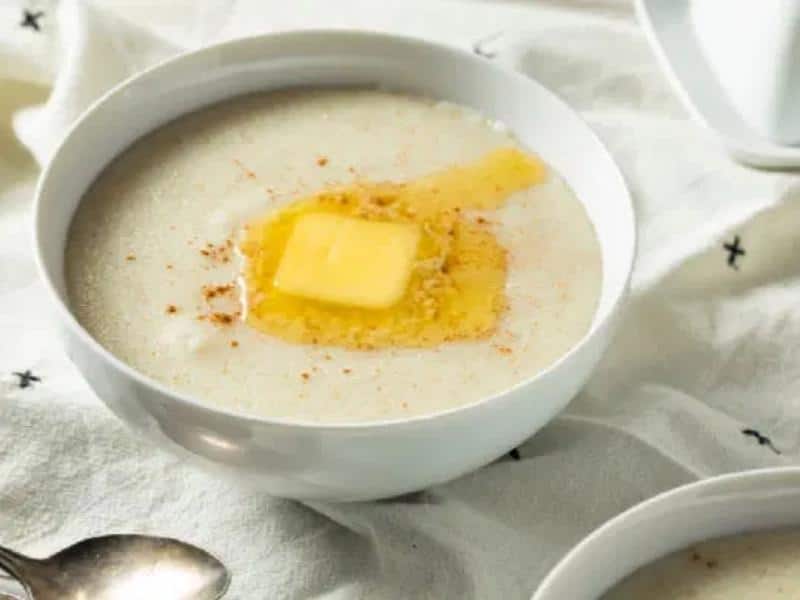
Home cooks often choose farina as a staple ingredient in many popular hot breakfast cereal recipes due to its smooth texture and versatility.
In cooking, farina has several common uses. It can be combined with milk to form a hot cereal, used as a thickener, or used as a flour or breadcrumbs substitute.
Traditional Farina Dish
The most traditional use of farina is as a hot breakfast cereal. To make this conventional farina dish that serves two to three people, you’ll need the following ingredients:
- 1 cup milk (dairy or plant-based)
- 1 cup water
- 1.5 cinnamon sticks
- 1 whole clove
- 1/2 teaspoon vanilla extract
- 1/4 cup honey (substitute for agave nectar if vegan)
- 1/4 teaspoon salt
- 2/3 cup farina
- 1 tablespoon unsalted butter
Place a small pot on the stove and set the stove to medium heat. Add the water, milk, cloves, cinnamon sticks, and salt. When the mixture begins to simmer, add the farina and butter and stir to combine. Add the honey, and constantly stir to prevent sticking.
Continue to stir for up to 5 minutes until you achieve your desired consistency. You can add more milk to the farina if the mixture gets too thick.
Before serving your dish, stir in the vanilla and remove the clove and cinnamon sticks. Serve with your favorite toppings of choice, like butter, cinnamon, or agave syrup.
Farina as a Breadcrumbs Replacement
You can use farina as a breadcrumbs replacement in any recipe that calls for breadcrumbs. You can use farina as a breadcrumb replacement as follows:
- As a binding agent for meat and vegetable burgers
- As an ingredient in meat and sweet pies
Farina absorbs moisture and juice, preventing pie crusts from getting soggy. Use farina instead of breadcrumbs on a 1:1 ratio.
Farina as a Thickener
Like corn flour and other flour, farina can be used to thicken gravies, soups, and sauces. Farina doesn’t have a raw flour flavor, which means it won’t change the flavor of your dishes.
To thicken liquids with farina:
- Combine one teaspoon of farina with two teaspoons of water and add this mixture to your dish on medium heat.
- Stir the dish to incorporate the farina.
- Continue to stir until the mixture thickens.
- Add another teaspoon of farina if the dish doesn’t thicken after two minutes.
Farina as a Flour Replacement
For those looking for a finer flour alternative, farina offers a smoother texture compared to other cereal grains.
Farina has a coarser texture than white flour, but you can still use farina as a white flour alternative to achieve similar baked results.
Farina can also be used in place of bread flour and cake flour. Like farina, both of these flours have been milled to a fine consistency. This means that farina will provide the right consistency and texture to your dishes when it’s used in place of bread flour or cake flour.
You should use farina as a flour replacement on a 1:1 ratio.
Farina vs. Similar Foods
Farina resembles Malt-o-Meal, Cream of Wheat, Semolina, and Cream of Rice. There are several differences between farina and these foods.
Malt-o-Meal
Malt-o-Meal is a ground wheat product that works well as a farina substitute. Malt-o-Meal isn’t as finely ground as farina and has a less creamy texture than farina. Because
Malt-o-Meal is bulkier than farina, less Malt-o-Meal is needed to provide a full feeling.
The flavor differences between Malt-o-Meal and farina are indiscernible. Farina and Malt-o-Meal are wheat products used to make hot, creamy cereals with added sweet ingredients.
Cream of Wheat
Cream of Wheat is the most popular farina product. Because Cream of Wheat is made from farina, it tastes almost identical to farina. However, depending on the Cream of Wheat product you buy, Cream of Wheat can taste sweeter or saltier than farina.
This is because Cream of Wheat products often contain added sugars and salts.
Cream of Wheat is more convenient than farina because it requires fewer ingredients to make a hot breakfast dish. Many Cream of Wheat products are already flavored with ingredients like chocolate and maple brown sugar.
This makes Cream of Wheat unhealthier than farina, but making Cream of Wheat require less cooking effort.
Semolina
Semolina flour and farina are made using the same process, but semolina is made from durum wheat, while farina is made from other hard wheat. Like farina, semolina is used to create a creamy breakfast dish.
Semolina and farina have different tastes. Semolina has a sweet, nutty flavor, while farina is plain and usually provides flavor from added sweeteners, like honey.
Cream of Rice
Cream of Rice is a gluten-free alternative to Cream of Wheat. A bland flour made from rice, Cream of Rice is most frequently combined with milk to create a hot breakfast cereal like farina.
Both Cream of Rice and Farina are rich in nutrients, such as iron, and both flours are good sources of carbohydrates. Cream of Rice has a blander flavor compared to farina and requires extra honey or a similar sweetener when eaten as a breakfast dish.
FAQs about Farina
Is farina healthier than oatmeal?
Farina and oatmeal both have some good things going for them health-wise. Oatmeal’s got more fiber and is usually lower in calories. But farina has iron and B vitamins. So I’d say it depends on what you’re looking for – if it’s fiber and weight loss, oatmeal might be better. But farina could be a good choice to get those nutrients.
Is farina good for diabetics?
For diabetics, farina is high in carbs so it can spike blood sugar. Keeping portions in check is important, and going for whole grain farina over refined may help with that blood sugar impact. Pairing it with some protein and healthy fat can also help to balance things out. So it can be an option, just take precautions.
Is farina high glycemic?
Farina tends to be high on the glycemic index. That means it can cause a rapid rise in blood sugar. Folks managing their blood sugar, like diabetics or those eating low-glycemic diets, should keep that in mind with farina.
Can farina be eaten raw?
We don’t recommend eating raw farina. It can be difficult to digest and poses some contamination risks. Cooking farina makes it safer and brings out the flavor. For the best results, it’s better to eat farina cooked.
Is farina hard to digest?
When cooked properly, farina has a smooth, fine texture that makes it pretty easy to digest. The simple carbs are broken down easily too. Raw farina or undercooked farina may be tougher to digest though and cause some stomach upset. But on the whole, cooked farina is gentle on the digestive system.

